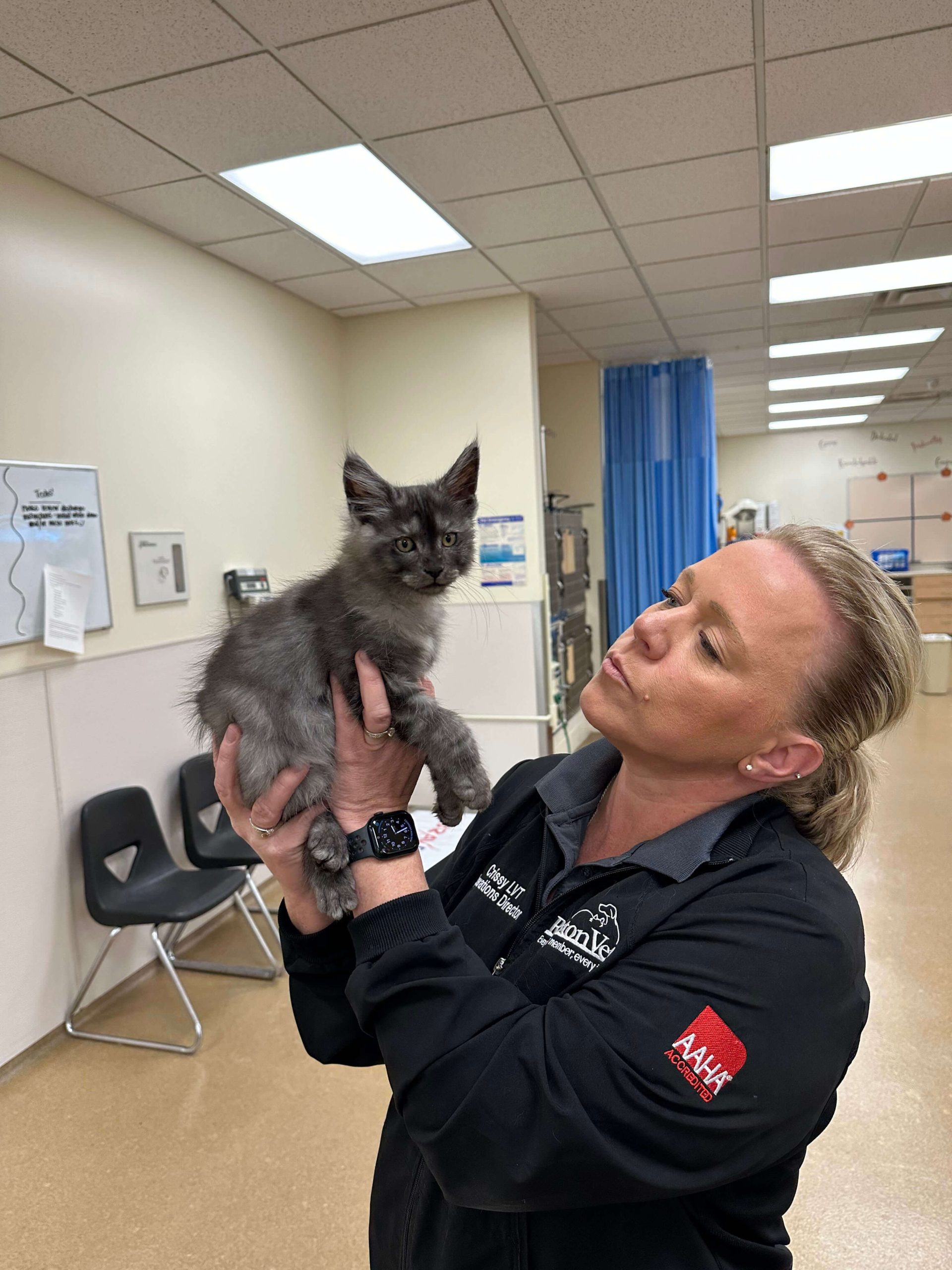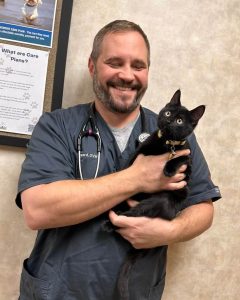 Vaccinations
Vaccinations
Vaccinations are an essential way to prevent many serious diseases in cats. Even if your cat is an indoor pet, they can still be exposed to viruses through the air, dust, or clothing. Vaccinations are an inexpensive way to protect your cat from costly treatment or even death.
Vaccinations usually start when the cat is around 6 weeks of age and should be boosted every 3-4 weeks until they are 16 to 18 weeks old. This helps to build antibodies in their blood and protect them from infections. Once all the necessary booster vaccinations are complete, yearly examinations and boosters are necessary to protect your cat for life.
Some of the core vaccines include:
– Rabies virus: is a severe neurological condition that can be transmitted to humans and is a fatal disease. The vaccine is recommended for all cats and should be given every 1-3 years.
– Feline Viral Rhinotracheitis, Calicivirus, and Panleukopenia (FVRCP) cause upper respiratory signs and can result in severe systemic infection. Infections are acquired from contact with infected cats and the environment. This vaccine is recommended for all cats and should be given every 1-3 years after initial boosters.
– Feline Leukemia Virus (FeLV) and Immunodeficiency Virus (FIV) are highly contagious and are transmitted from cat to cat. Both are known to attack a cat’s immune system, and positive cats can develop bacterial, fungal, and viral infections, as well as cancer. Testing should be done on all kittens, new cats in a household, and all sick cats. Although there is a vaccine for FIV, it is not recommended as it can cause positive testing and result in a misdiagnosis of infection. All kittens should be vaccinated for Feline Leukemia, and lifestyle should be assessed when they are older to determine if vaccinations should be continued. All outdoor cats should be vaccinated for Feline Leukemia.
The vaccination schedule is as follows:
 – 6th – 8th week vaccinations:
– 6th – 8th week vaccinations:
Complete Physical Exam
Viral Rhinotracheitis
Calicivirus
Panleukopenia
Fecal exam
– 9th – 12th week vaccinations:
Complete Physical Exam
Viral Rhinotracheitis
Calicivirus
Panleukopenia
Feline Leukemia*
– 12th – 16th week vaccinations:
Complete Physical Exam
Viral Rhinotracheitis
Calicivirus
Panleukopenia
Feline Rabies
Feline Leukemia*
– Annual Boosters:
Complete Physical Exam
Viral Rhinotracheitis
Calicivirus
Panleukopenia
Feline Rabies
Feline Leukemia*
Fecal Exam
Health Assessment blood work
*Our doctors and staff will discuss lifestyles and risk factors for each of your pets.
Parasites
Intestinal parasites like Hookworms and Roundworms are common in cats and can make them very sick if left untreated. Routine deworming during kittenhood and an annual stool sample evaluation is recommended to check for these parasites. However, due to intermittent shedding, all parasites may not be detected on routine stool exams. These parasites are zoonotic, which means that people can get them from their cats. It is important to practice good hygiene, such as washing your hands after changing the litter box, to prevent infection.
Heartworms
Heartworms, which are spread by mosquitoes, can infect both indoor and outdoor cats. Prevention is recommended year-round. Even a small number of adult worms can cause severe disease in cats, leading to respiratory distress, heart, kidney, or liver failure, and possibly death. There is no treatment for cats infected with heartworms. Your veterinarian or staff member can guide you in selecting the best product for your cat.
Flea and tick
Fleas and ticks are carriers of infectious diseases that can cause illness in your pet. It is recommended to use flea and tick preventives year-round to protect your pet from transmission of these diseases. Your veterinarian or staff member can assist you in selecting the best product for your pet.
Pet insurance
is a wise investment for pet owners who want to ensure their furry friends get the best possible health care. It can help protect your pet from unexpected accidents or illnesses and provide financial assistance for routine checkups, vaccinations, and even emergency surgeries. With pet insurance, you can rest assured that your pet’s health and well-being are taken care of without breaking the bank. Some pet insurance policies even offer coverage for alternative treatments like acupuncture or chiropractic care. When considering pet insurance, be sure to compare policies and read the fine print to choose the best plan for you and your pet’s needs. Please follow the link to help you find the best insurance for your pet.
https://www.pawlicy.com/
 Care Plan
Care Plan
Recognizing the importance of making preventive care more accessible, we are pleased to offer Preventive Care Plans! These plans cater to pets at every life stage, from playful puppies & curious kittens to wise senior companions. By opting for our Care Plans, you can enjoy the convenience of affordable monthly payments, eliminating the stress of a hefty one-time expense. This way, you can work with our team to ensure your pets receive the best preventive care they need for a healthy and happy life! Our goal is to keep financial considerations from standing in the way of your family’s well-being. Follow this link for more information! https://ralstonvet.com/care-plans-cat/
Spay
Spaying female cats involves surgical removal of the ovaries and uterus. This procedure has several advantages such as preventing pregnancy, elimination of heat cycles, and behavioral changes. As female cats get older, they have an increased risk of breast cancer and uterine infection if they are not spayed. It is recommended to discuss with your veterinarian about the appropriate age for spaying. As a general guideline, it is recommended to be performed after 6 months of age.
Neuter
Neutering male cats involves surgical removal of the testicles. Neutering may help discourage aggression, hyperactivity, marking, roaming, and fighting. Neutering your male cat will eliminate the risk of testicular cancer and infection, as well as certain prostatic problems. It is recommended to discuss with your veterinarian about the appropriate age for neutering. As a general guideline, it is recommended to be performed after 6 months of age.
Microchipping
Microchipping your cat is a simple and effective way to ensure that you can find them if they ever get lost. A microchip is a tiny device, about the size of a grain of rice, that your vet can implant under your cat’s skin. It contains a unique identification number that can be read with a scanner. If your cat is ever lost and taken to a shelter or vet, they can scan the microchip to retrieve your contact information and quickly and safely reunite you with your cat. It’s important to keep your contact information up to date with the microchip company to ensure that you can be reached if your cat is found. Microchipping is a safe and painless procedure that can be done by your vet during a routine visit. It’s a small investment that can provide peace of mind and ensure that your furry friend is always protected. For more information, please follow the link. https://ralstonvet.com/microchipping/
 Nails
Nails
Kittens have sharp toenails that can be trimmed with human fingernail clippers or with nail trimmers made specifically for dogs or cats. It is recommended to use nail trimmers made specifically for pets. Be cautious not to cut too much of the nail as it can cause bleeding and pain. With white or clear nails, you can see the pink quick through the nail. Use a sharp blade on your trimmers, as dull blades tend to crush the nail down and cause pain. Keep styptic powder available in case of bleeding. If you do not have styptic powder, you can use flour or cornstarch as a substitute to stop the bleeding.
Declawing should ONLY be considered after all other attempts have been made to prevent the cat from using its claws destructively or when clawing presents a significant health risk for people within the household. Before pursuing surgery, try frequent nail trimming, multiple scratching posts, and soft paws (soft nail caps that are glued on top of the nail). Declawing is a surgical procedure that involves the amputation of the third phalanx. A front declaw is preferred compared to an all-four paw declaw. It is best to declaw cats at the young age of about five months old. Young cats tend to recover more quickly and adapt better to the loss of their claws. This procedure can be painful and requires close monitoring for signs of pain as this potentially could lead to chronic pain. Cats that are declawed should be kept indoors only.
Introduction to the home
When introducing a cat to a new home, it is recommended to limit the cat’s exploration to one room initially. This will help prevent the cat from being overwhelmed by its new surroundings. After a few days, you can allow your cat access to other areas of the home. It is important to kitten-proof your home by keeping wires, string-like objects, and plants out of your cat’s reach. Provide acceptable items to chew on such as a small pot of wheatgrass or a fishing pole type of toy.
The ideal socialization period for cats is between 2 and 12 weeks of age. During this time, cats are very impressionable to social influences. If they have good experiences with men, women, children, dogs, other cats, etc., they are likely to accept them throughout life. If experiences are absent or unpleasant, cats may become apprehensive or adverse to any of these. Therefore, during that period, it is important to expose your cat to as many types of social events and influences as possible. Feliway, a pheromone product, can be used to ease the transition to a new home. It is available as a spray for bedding and other products as well as a diffuser to be plugged into a wall socket.
 Litter Box Basics:
Litter Box Basics:
House training a kitten is usually much easier than training a dog. Most kittens are naturally attracted to a litter box for elimination. However, problems can arise if the litter box is not accessible, clean or attractive. Sometimes, a kitten may find alternative spots like the dirt in a potted plant equally attractive for eliminating. Therefore, it is easier to avoid litter box problems in the first place. Routine cleaning with soap and water and daily scooping are mandatory. In a multi-cat household, there should be one more litter box than the number of cats. Also, make sure to place the litter box near your kitten’s core living area, so it can easily access it. For some kittens, it may be necessary to restrict them to a smaller area with a litter box until usage patterns are established. If your kitten has a medical issue that causes increased urgency or frequency of elimination, you should see a veterinarian.
Oral Hygiene
Paying attention to your cat’s teeth and gums is vital for their long-term health. Poor oral hygiene can lead to various health problems, including heart, kidney and liver diseases, and compromise your cat’s immune system. Therefore, it is crucial to start a regular teeth-cleaning routine for your kitten. You can begin by wrapping a small piece of cloth or gauze around your finger and wetting it with warm water or even chicken broth. Then, gently rub the kitten’s teeth and the outside surfaces. This massaging action may even feel good to your teething kitten. Permanent teeth start arriving between 3 to 6 months. Once your kitten is comfortable with the routine of rubbing teeth with your finger, you can gradually introduce a soft-bristled brush with toothpaste made specifically for cats. Do not use human toothpaste. Most cats need professional teeth cleaning once or twice a year. The need for professional cleaning can be assessed during the yearly preventive care exam. By cleaning your cat’s teeth at home at least three times a week, you may need to have professional cleaning done less often. For more information click here. https://ralstonvet.com/dental-care/
If you have any questions or concerns, please feel free to call us during business hours. You can ask to speak with a staff member, and they will be happy to assist you. Congratulations and good luck with your new kitten!
